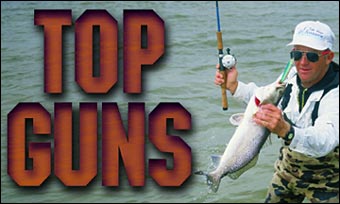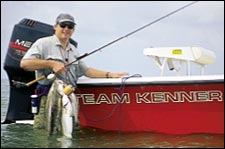
Scratching the surface with topwater plugs
is as addictive as it is productive.
By Larry Bozka
page 2
Deep thoughts
Last summer, I received report after report of fishermen off
the Galveston Jetties pulling massive catches of trout and redfish
from the rocks. That's not unusual when the jetty locale is a
generally accepted topwater hotspot like the Bolivar Pocket or
even the flats around Fort Travis. Off the end of the north jetty,
however, with the lures floating high above some 40-feet-plus
of ship channel saltwater, it's unconventional at the least.

The oyster reef of San Antonio Bay yielded this nice stringer of specks and reds to Bill Kenner of Kenner Boats. Fishing from a new 21-foot Vision, Kenner and crew used both soft plastics
and topwater plugs to pull the fish off of the shell. Coastal
Bend bays-particularly San Antonio, Mesquite and Carlos-are all
topnotch areas for working oyster reefs.
|
Water conditions can certainly play a role. If it's rough, it
makes it tough. But the element of sound cannot be ignored or
underestimated. Virtually all of today's most popular topwaters
contain rattle chambers (notice how the entire MirrOlure line
now sports an "R" at the end of the model numbers?),
and the lures have been continually modified to magnify their
sound-producing capabilities.
You can hear a Top Dog or a Super Spook coming back at you from
a long way away. Considering that sound travels roughly 250 times
faster underwater, don't think for a second that predator fish
are not hearing it as well.
Bigger ain't always better
MirrOlure's Top Dog, Jr., Excalibur's Super Spook Jr. and Spittin'
Image and Owner's Cultiva Gobo Popper and Zippin' Ziggy are all
members of the new downsized clan of topwater offerings. I still
maintain that bigger is better for larger fish-especially trophy-class
trout chasing mid-sized mullet-but there are nonetheless days
when the fish feed on substantially smaller forage. If the prevalent
bait in the area consists of small shad, glass minnows, saucer-eyed
shiners and the like, it often pays to "match the hatch"
with smaller offerings.
One advantage of doing so, incidentally, is that these lures
can be efficiently fished on the same light-action 7-foot, fast-taper
rod you use to throw shrimptails. When working the bigger plugs,
you're much better off with a fast-tapered 6- or 6-1/2-footer
with a medium-light action. You'll enjoy greatly increased control
of the lure, and your wrist muscles will hold up much, much longer
than they will while flailing a 5/8-ounce plug on a long, lightweight
trout rod.
An unclear situation
Clear water is imperative to topwater success, right?
Not necessarily so.
Fact is, I'd rather fish off-colored water than stuff that looks
like it came straight out of a Tanqueray bottle. Baitfish, after
all, gravitate toward murky water because they can literally hide
in it. Predator species, conversely, frequent murky zones because
they can sneak up on the forage fish in hiding.
As an example, consider the "mud streaks" that tend
to be so productive when wintertime temps clear up bay waters.
Trout and reds hang on the clear-water fringes; place a bait in
the dirty zone and bring it out and it's very likely to get hammered.
Too much silt and mud can kill a spot, partly because dissolved
oxygen levels in such areas can fall to precipitous levels. But
don't ignore a spot simply because the water is off-colored.
If there is any kind of color change at all in the area, give
it a thorough topwater thrashing before moving on.
Topwatering the surf
Again going against the grain, the sudsy world of half-ounce
Tony Accetta spoons, Suspending Husky Jerks and sinking 52MR MirrOlures
is equally prone to rewarding topwater casters-especially if you
can effectively read the conditions.
Color changes-especially "cuts" that slice across sand
bars-always merit a shot. Surf-running fish use such perpendicular
cuts to move in and out from the beachfront, and you'll frequently
find those fish much closer to the sand than you'd expect. This
is particularly true during high-tide phases.
For this reason, resist the urge to cast your lure as far out
as possible. Sure, try hitting the third bar; big topwater plugs
are great for conquering incoming southerly breezes. But always
give the lateral shot a try before moving out. Cast the lure straight
to your left or right, and bring it back parallel to the beach.
Remember, baitfish-and the predators they feed-also move parallel
to the sand, not directly inshore and offshore.
Baitfish activity and tidal flow are arguably more critical in
the surf than anywhere else. Couple a moving tide near a bay-to-Gulf
pass with thick, roving pods of finger mullet and you have a topwater
assault waiting to happen.
A technique that's for the birds
Speckled trout feeding beneath working flocks of gulls are most
often pursued with shrimptail and shadtail jigs, and understandably
so. The single-hooked "tails" are easy to remove from
small schoolies that must be quickly unhooked and released.
Back to the "big fish, big bait" theorem, though: To
selectively target larger school trout, you can't go wrong with
a topwater. Plug-chasing seagulls can be a pest, and sometimes
the trout are simply too small to make it worth the hassle of
fishing a multi-hooked lure.
But when big trout are mixed in with the schoolies-which is the
case more often than many of us suspect-a topwater plug can separate
the schoolies from the sows. Bigger specks almost invariably wait
beneath feeding school trout. The bigger they get, the lazier
they get. Some might call it "smarter."
Big trout expend no more energy than absolutely necessary to
procure a meal. It's not worth charging through a dense school
of "pencil trout" to eat a tiny bite of shrimp. Much
more efficient, rather, to hold deep and wait for the crumbs to
fall. However, a topwater plug and the full-meal mullet it resembles
is often enough to make a big speck work for its lunch.
The constants remain
A few principles of the topwater equation remain, if not in stone,
solidly etched in fact.
1) You're usually better off if you work a topwater plug slowly
as opposed to a fast, nonstop "walk the dog" retrieve.
2) A loop knot, or at least a split ring on the lure nose, greatly
enhances the lure's to-and-fro "walking" capabilities.
3) Mid-day action-especially under overcast skies-isn't unusual,
but prime conditions for big-trout topwater plugging usually occur
in the early-morning and late-evening hours.
4) Particularly under a full-moon phase, nighttime wade fishing
with topwaters remains a largely unexploited but hugely productive
option.
5) If a fish "blows up" on a bait, don't immediately
reel in the lure. Let it rest a moment; then give it a light twitch.
Odds are the predator is still looking at the fake mullet it just
stunned, and the follow-up twitch frequently prompts the fish
to finish off its prey.
If that doesn't work, reel in and throw back to the same spot.
The fish, usually, will still be there.
And finally-
6) Know that you'll be a dead duck yourself after your first
productive topwater outing.
This is one craze that's not going to pass with the next "hot
trend."
# # # #
page 1 / page 2
| 




